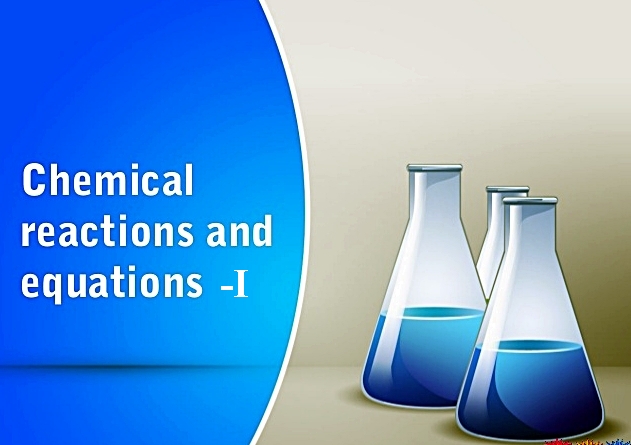Chemical Reactions and Equations-
Types of Chemical Reactions
Introduction
Chemical reactions involves making and breaking of bonds between
the reacting atoms to produce new substances. Here we will focus on what are
the different types of chemical reactions and what are the factors involved in
bond formation.
1. Combination reaction: In this type of reactions two or more reactants combine to form a single product. Large amount of energy is released during this reaction.
1. Combination reaction: In this type of reactions two or more reactants combine to form a single product. Large amount of energy is released during this reaction.
A
+ B → C
(Reactants) (Product)
|
Example: Quick lime (CaO) reacts with water to
produce slaked lime Ca (OH)2 and large amount
of energy is released.
CaO(s)
+ H2O(l)
→ Ca(OH)2 (aq)
+ Energy
(Quick lime) (Slaked
lime)
(Calcium
oxide) (Calcium hydroxide)
2. Decomposition reaction:
It involves the breaking down of a single compound into two or more simpler
substances. The reactant can be decomposed either by heat (thermal
decomposition), electricity, and sunlight (photo decomposition).
A
→ B + C
(Reactant) (Products)
|
a) Thermal decomposition: A reactant breaks down
into two or simpler substances or products on heating.
i. Decomposition
of Ferrous sulphate
2FeSO4 (s)
→ Fe2O3 (S) + SO2
(g) (↑) + SO3 (g) (↑)
Observation- Ferrous sulphate crystals (FeSO4.7H2O)
lose water when heated and the color of crystals changes from green to white
(FeSO4). It then decomposes to ferric oxide, sulphur dioxide and
sulphur trioxide.
ii.
Decomposition of Calcium carbonates (Limestone)
CaCO3
(S) → CaO (s) + CO2 (g)
(↑)
Used in manufacture of cement
iii. Decomposition
of Lead nitrate
2Pb (NO3)2
(S) → 2PbO(S) +
4NO2 (g) (↑)
+ O2 (g) (↑)
(Lead
nitrate) (Lead oxide) (Nitrogen
dioxide) (Oxygen)
Observation- The emission of brown fumes is characteristics
of this reaction.
b) Electric decomposition: A
reactant breaks down into simpler substances or product on passage of
electricity.
i.
Decomposition of water
2H2O
(l) → 2H2 (g) (↑) + O2 (g)
(↑)
Observation – On passing electricity through water hydrogen is
liberated at cathode (negative electrode) and oxygen is
liberated at anode (positive electrode) in the ratio 2:1.
c) Photo decomposition:
A single substance breaks down into two or more substances by sunlight.
i. 2AgCl
(s) →
2Ag (s) + Cl2 (g)
(Silver
chloride) (Silver)
(White) (Grey)
ii. 2AgBr
(s) →
2Ag (s) + Br2 (g)
(Silver
bromide)
(Silver)
(Bromine)
(Yellow)
(Grey)
Note: These reactions are used in black and white photography.
3. Displacement reaction: More
reactive element displaces the less reactive element from its salt solution.
The displacement of elements is based on the reactivity series.
A
+ BSO4 →
ASO4 + B
(Salt solution)
|
Reactivity series: The reactivity series is a list of metals
arranged in the order of their decreasing activities.
Example: Zn +
CuSO4
→ ZnSO4 + Cu
(Zinc) (Copper sulphate) (Zinc sulphate) (Copper)
4. Double
displacement reaction: Exchange of ions takes place between the compounds
to form new compounds. A precipitate is formed as a result of double
displacement reaction.
Precipitate – Insoluble solid that settles down at the bottom when two
compounds react. It is shown by ↓ in the chemical reaction.
A+ B-
+ C+ D-
→ AD + CB
|
Example: Reaction between lead nitrate and potassium iodide
so as to give lead iodide (Yellow ppt.) and potassium nitrate.
Pb(NO3)2
(aq) + KI (aq)
→ PbI2 (↓)
+ KNO3
(Lead nitrate) (Potassium iodide)
(Lead iodide) (Potassium nitrate)
(Yellow precipitate)
5. Oxidation
and Reduction Reactions:
a) Oxidation:
It can be defined as, the process in which oxygen is added and hydrogen is
removed. Also the process in which a substance loses electron(s).
b) Reduction:
It can be defined as, the process in which hydrogen is added and oxygen is
removed. Also the process in which a substance gains electron(s).
c) Oxidising
Agent: A substance which helps in the oxidation of another substance. Oxidising
agent itself gets reduced.
d) Reducing Agent:
A substance which helps in the reduction of another substance. Reducing agent
itself gets oxidised.
6. Exothermic
Reactions: The reactions in which heat/energy is released along with the
formation of products.
Example: Respiration is an exothermic process. Food contains carbohydrates;
these carbohydrates are broken into glucose. This glucose combines with oxygen
in the cells and provides energy.
C6H12O6 (s) +
6 O2 (g) → 6 CO2
(g) + 6 H2O
(l) + Energy
Glucose
Oxygen
7. Endothermic
Reactions: The reactions in which heat/energy is needed for the reaction to
occur.
Example: Photosynthesis is an endothermic process.
6 CO2 (g) + 6 H2O
(l) + Energy →
C6H12O6 (s) +
6 O2 (g)
Prepared by Ms. Priti Maan










2 Comments
hlo
ReplyDeleteChemical reaction a process that involves rearrangement of the molecular or ionic structure of a substance, as distinct from a change in physical form or a nuclear reaction. It is a very important part of chemistry because chemistry subject is connected with chemical reactions and equations. So it is very important for students who want to learn chemistry they can take help of Chemistry Tutor for clear the basic concepts of reactions.
ReplyDelete